Monday, 13 June 2011: Villefranche-sur-Saône, on Pentacost
Written 26 June 2011
On Monday, as we knew, the tourist office in Anse was "exceptionally" closed, but we were hoping to find some information on possible vineyard or winery tours in the Beaujolais country. Anse is just south of Villefranche-sur-Saône, which is apparently the capital (at least for wine-trading purposes) of the Beaujolais, so we fired up the car and set off for there, hoping its tourist office would be open.
The city map in the Michelin Guide showed the locations of public parking lots as well as the Office de Tourisme, so we set off confidently, planning to park in the most central lot—the one next to the covered market—unless, I said jokingly, it's market day. Of course, it was, so 2/3 of the lot was covered with clothing stands, and the remaining portion was not only parked up but traffic-jammed with others looking for spaces. So David chose a side street at random, and four or five blocks later, we found a space—it was even free.
Our Michelin Guide is at least 20 years old; we bought it in 1991, and who knows when it was last revised before that. Anyway, it's a little out of date. This was only the first of several occasions on which we found that the tourist office had moved since our guide was printed. It wasn't where we expected to find it, but helpful signs directed us to its new location, where we found that it was, drat, closed. As we stood on the sidewalk grumbling, and trying to see in the windows, a group of ladies returning from the market volunteered, "It's Pentacost, you know." We slapped our foreheads; Pentacost! Of course. We'd even seen it on the TV news. The same dratted holiday that caused such a stir at Ifremer in Brittany back in 2005. Pentacost has long been a "jour ferrié" in France, a bank holiday and a paid holiday for most salaried workers. Back in 2004 or 2005, somebody—I don't know who—decided that it should instead be an unpaid workday, the earnings for which would go to help the elderly. This did not sit well with at least a large plurality of the French (Françoise can't even see how American companies get their employees to show up to ride on parade floats on holidays—"you mean they just give their time to be in the parade, without evening being paid!"), so to this day the whole concept remains hotly controversial. Droves of employees call in sick. Businesses like restaurants and bakeries that are always closed on Monday nonetheless post notices that they will be closed on Pentacost Monday. That's why the Anse office was "exceptionally" closed on Monday—not because it was a holiday but because they didn't want to work that day.
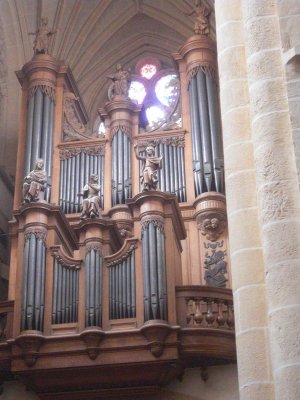
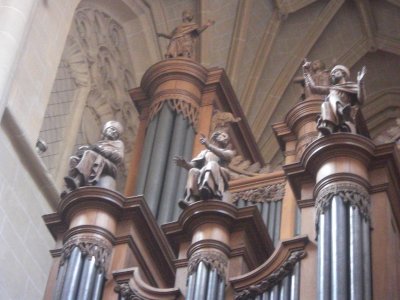 So much for getting any tourist information about the area. So we just set out to explore the downtown. The Michelin Guide recommended the boiseries in the church, so we started there (always a good place to start—the vast majority of French churches are way older than anything in the US, so there's usually something to see).
So much for getting any tourist information about the area. So we just set out to explore the downtown. The Michelin Guide recommended the boiseries in the church, so we started there (always a good place to start—the vast majority of French churches are way older than anything in the US, so there's usually something to see).
As promised, although not as extensive as some, the wood carvings were excellent. These, shown in both distant and closer views, were high overhead, adorning the organ loft.
Most churches also have carved wooden pulpits, but in this one both the baptismal font and the pulpit were of marble, or perhaps porphyry, arranged in panels of different colors.
The name of the church is "Notre Dame des Marais" (Our Lady of the Marshes) because when it was built, before the foundation the the town, the site was a swamp. Church authorities were looking for a place to put a new church when peasants reported finding their cattle and sheep out in the swamp, in a circle, kneeling to a status of the Virgin Mary. The authorities fetched the statue in from the swamp and placed it temporarily in an existing church, planning to put it in the newly built one, but the next morning, the livestock was all back out in the swamp, at the same spot, again kneeling to the statue, which had miraculously returned to its original position. The authorities then yielded to what was clearly a divine directive and built the new church right there in the swamp (and were obliged to sink an amazing number of very large pilings to make in stand stead on such marshy ground. I didn't get straight whether any of the statues we saw inside was the original one.
A plaque outside commemorates the presence of Anne de Beaujeu and her husband, Duc de Bourgogne, at the application of finishing touches to the building and thanks them for all their help and support it getting it built. (Beaujeu is the nearby village for which the Beaujolais is named. And remember Anne de Beaujeu, first sister-in-law and educator of Marguerite d'Austriche during her childhood marriage to the future Charles VIII of France?)
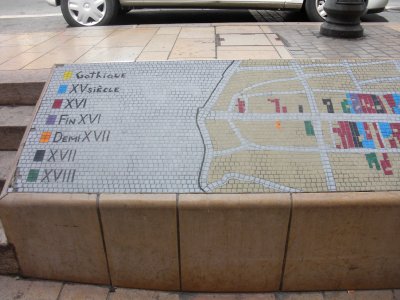
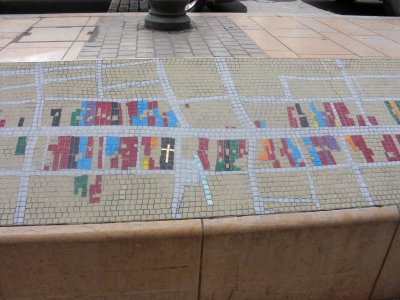 Villefranche, aside from being Beaujolais Central, is known for its historic architecture. A couple of blocks from the church, we came across this wonderful tiled diagram of the main street, rue National. Each photo shows maybe a quarter of it. At the left is the key to tile color, indicating the century during which each of the buildings was constructed. The church is recognizable by its gold cross. We didn't take time to puzzle out just which building housed our lunchtime restaurant, but it was in about the third block to the right of the church, on the same side of the street.
Villefranche, aside from being Beaujolais Central, is known for its historic architecture. A couple of blocks from the church, we came across this wonderful tiled diagram of the main street, rue National. Each photo shows maybe a quarter of it. At the left is the key to tile color, indicating the century during which each of the buildings was constructed. The church is recognizable by its gold cross. We didn't take time to puzzle out just which building housed our lunchtime restaurant, but it was in about the third block to the right of the church, on the same side of the street.
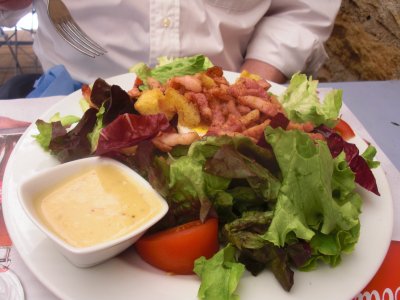
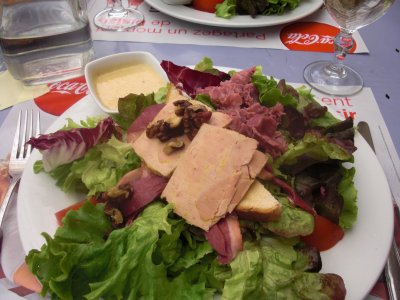 The restaurant had a sign on the street, but when you entered through its doorway, you found yourself in a dark, narrow traboule leading to an open courtyard deep within the building. That was furnished with blue-painted metal lawn furniture and sheltered by a large awning.
The restaurant had a sign on the street, but when you entered through its doorway, you found yourself in a dark, narrow traboule leading to an open courtyard deep within the building. That was furnished with blue-painted metal lawn furniture and sheltered by a large awning.
Here are our usual lunch salads, David's on the left, with the egg, croutons, and lardons and mine on the right with the foie gras, gizzards, and duck breast. Creamy vinaigrette on the side for both.
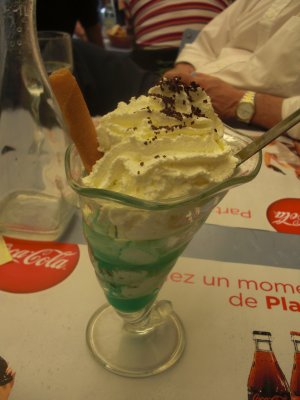
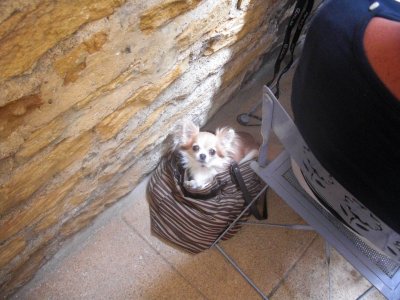 I couldn't resist dessert when I saw that they offered a "coupe igloo" (called "coupe iceberg" elsewhere in france), mint ice cream with mint syrup. David shudders at the very thought.
I couldn't resist dessert when I saw that they offered a "coupe igloo" (called "coupe iceberg" elsewhere in france), mint ice cream with mint syrup. David shudders at the very thought.
Throughout the meal, this quiet and patient young papillon waited in his mistress's handbag, just behind my chair.
Nice town, Villefranche. I admired its Christmas street decorations, which they apparently don't bother to take down out of season. We'd like to visit again sometime, when the tourist office is open so that we can see what we've overlooked and maybe learn more about the Beaujolais wine country.
A final fun fact about the place: The big flat paving stones in front of the church are called "callades." Once Villefranche was founded, around the church, especially to serve as a duty-free market town, the markets were held on that paved area, and people who traveled there to sell their wares spoke of going "on the callades." Going on the callades came to mean "hitchin' up the buckboard and goin' to town," and the people who actually lived there starting being called "calladois"—callade-dwellers. To this day, a person from Villefranche is called not a "Villefranchian" or a "Villefranc" but a "Calladois," which explains a whole heck of a lot of otherwise incomprehensible advertisements and business names!
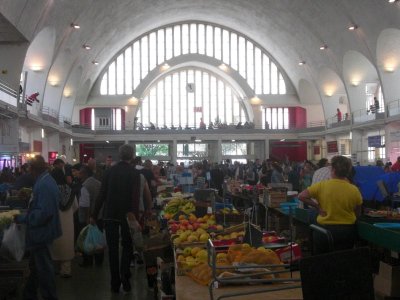
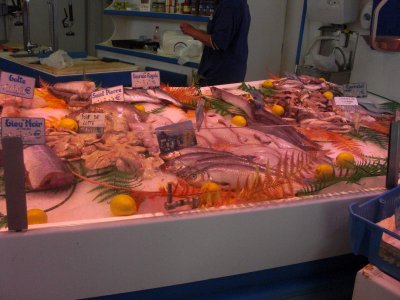 On the way back to the car, I talked David into a quick turn through the covered market. Outside, it was all clothing, as far as the eye could see. Inside was the food. In addition to all the normal stuff, they had strange flat turnips, shaped like those seedless "donut" peaches. I hope they're especially tasty, because they sure don't look like fun to peel.
On the way back to the car, I talked David into a quick turn through the covered market. Outside, it was all clothing, as far as the eye could see. Inside was the food. In addition to all the normal stuff, they had strange flat turnips, shaped like those seedless "donut" peaches. I hope they're especially tasty, because they sure don't look like fun to peel.
On the left is a view of the covered market, just a huge empty room in which vendors set up their stalls along more or less straight aisles. On the right is a fish display I was taken with (only part of this one, and this one only one of several). Pretty much zero overlap with the species we get in Tallahassee. Note, in particular, to the right of the "Lieu Noir," the pale, multilobed "foie de lotte" (monkfish liver); it's used to make a delicacy we sampled in Brest, called "foie gras de la mer" (foie gras of the sea).
That night, David drove over the mountain to Bagnols, so it was my turn to look at the scenery. Truly spectacular views, which I found it very hard to photograph. Our plans to park in the same spot, just outside the gates, were foiled by a pétanque tournament, which occupied the town square that day, so we had to park a little farther afield. Then the automatic catch on the postern gate stuck, and we spend several minutes in conversation with the receptionist over the intercom, being repeatedly buzzed through before we could get it open. This time, though, I had my camera at the ready when the door finally yielded.
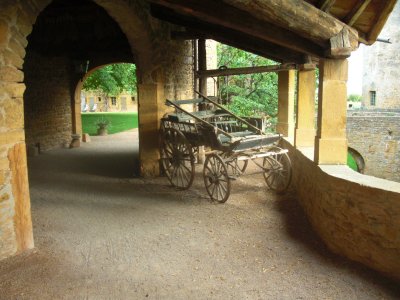
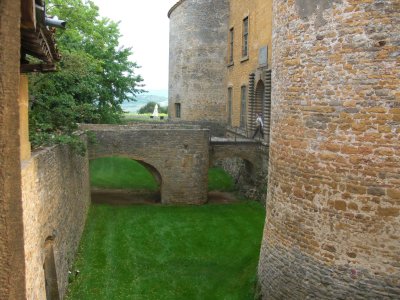 At the left is the carriage house (actually more of a shed, but it did have the old carriage in it). I'm standing just inside the postern. Out of the photo to the right is the gravel courtyard where hotel guests park their cars (just inside the big iron gates). Beyond the carriage, you can see a little of the grassy outer courtyard (which the hotel calls the "salon ombragé," the shaded salon) and to the right of it the beginning of the bridge into the inner castle. The right-hand photo shows the whole bridge, including the drawbridge part, and the waiter on his way out from the restaurant to greet us.
At the left is the carriage house (actually more of a shed, but it did have the old carriage in it). I'm standing just inside the postern. Out of the photo to the right is the gravel courtyard where hotel guests park their cars (just inside the big iron gates). Beyond the carriage, you can see a little of the grassy outer courtyard (which the hotel calls the "salon ombragé," the shaded salon) and to the right of it the beginning of the bridge into the inner castle. The right-hand photo shows the whole bridge, including the drawbridge part, and the waiter on his way out from the restaurant to greet us.
The massive building to the right in the right-hand photo is the castle proper—the seriously defensible part, built between 1217 and 1221 by Guichard d'Oingt and surrounded by the deep dry moat (it was always dry, designed that way) and surrounding the inner, stone courtyard. It's walls, exterior and interior, are 1 to 1.5 m thick The guardroom (and hence the restaurant, kitchens, etc.) was, of course, in that part, together with some of the hotel rooms. The outer part, a larger three-sided structure in the shape of three sides of a square, built around the grassy outer courtyard, houses more hotel rooms. That building ends at the moat and does not touch the inner castle, which is accessible only at the drawbridge.
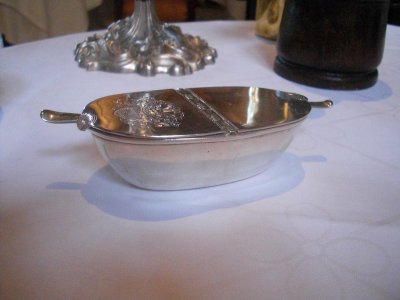
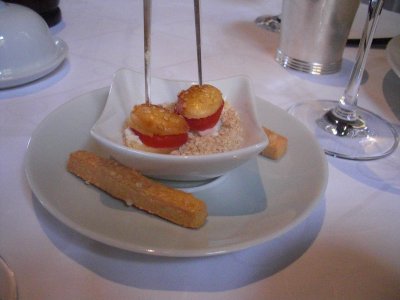 As he seated us at our table, the sommelier (doubling as maître d' that night) mentioned that, if we wanted to repeat the Guichard d'Oingt menu, we could substitute other dishes from the menu for the ones we'd already eaten—very accommodating.
As he seated us at our table, the sommelier (doubling as maître d' that night) mentioned that, if we wanted to repeat the Guichard d'Oingt menu, we could substitute other dishes from the menu for the ones we'd already eaten—very accommodating.
Here's the two-sided salt-cellar, coarse-grained salt on the left, fine-grained on the right, each with its tiny spoon.
First amuse-bouche, with David's champagne: Tiny tomato and cheese sandwiches (on tender one-inch buns baked for the purpose) on a bed of sesame seed. Savory shortbread bars on the side.
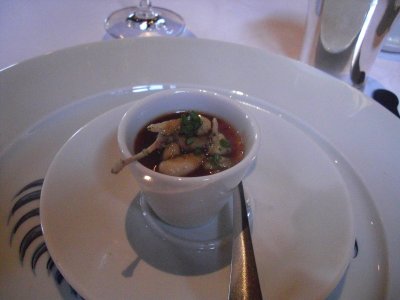
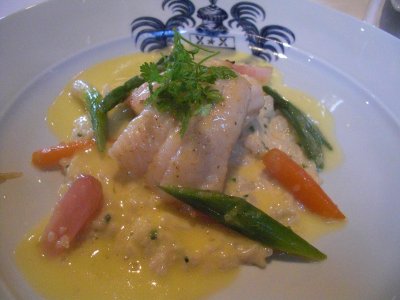 Second amuse-bouche: Hot frog and seafood soup. Delicious! Each piece of frog was either boneless or semidetached from its bone so that it could conveniently be bitten off.
Second amuse-bouche: Hot frog and seafood soup. Delicious! Each piece of frog was either boneless or semidetached from its bone so that it could conveniently be bitten off.
First course: We repeated the foie gras from the night before.
Second couse: Sole, roasted on the bone, then detached and given a final glazing on a bed of beef-marrow risotto, garnished with perfectly tender-crisp baby vegetables and napped with a buttery sauce. Wow.
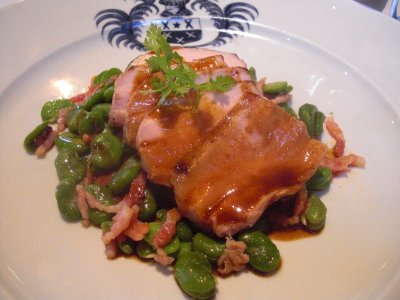
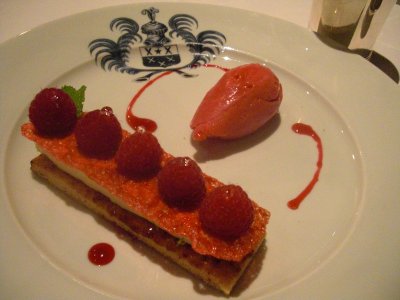 Third course: A thick pork chop, grilled and then sliced, on a ragout of baby broad beans, confit tomato, and lardons. Tender and moist, because it wasn't overcooked, as American pork always is.
Third course: A thick pork chop, grilled and then sliced, on a ragout of baby broad beans, confit tomato, and lardons. Tender and moist, because it wasn't overcooked, as American pork always is.
Cheese: For me, an old, dry Comté, a dry ashed chevre, and an interesting chevre marinated in olive oil and herbs. For David, Morbier, Camembert, and I think a brebis of some sort. Walnuts and apricots with all of the above and what was probably the best walnut raisin bread we've ever had. The chef should be famous for that alone.
Dessert: Raspberries and litchis, in a charlotte and a sorbet. Note the single glistening drop of sugar syrup atop each raspberry. The raspberries themselves were excellent, and the raspberry-litchi sorbet was out of this world.
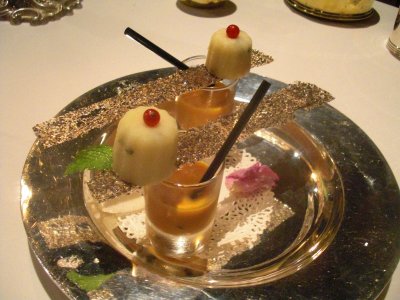
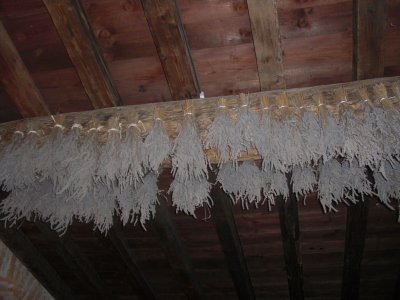 Mignardises: Same as the night before, but this time with a golden fruit smoothie in the glasses. The restaurant was rated only 15/20 in the 2009 GM and two toques in this year's. After two such meals, we seriously wondered why it wasn't rated higher!
Mignardises: Same as the night before, but this time with a golden fruit smoothie in the glasses. The restaurant was rated only 15/20 in the 2009 GM and two toques in this year's. After two such meals, we seriously wondered why it wasn't rated higher!
During dessert, the chef came out of the kitchen to visit each table, and he asked where we were from. When we said Florida, he broke into excited, and quite good, English! He used to work for the Ritz Carlton people, and he spent many years in Chicago and some in Atlanta (we've eaten at that Ritz Carlton, but I don't think it was while he was there), then 12 years in Tokyo, before leaving them to come to Bagnols. He asked how we liked the rest of the castle, and when we admitted that we weren't staying there and hadn't seen it, he insisted on coming back after we'd finished eating to show us around!
He was as good as his word; we found him waiting for us in the lobby when we emerged from the Salle des Gardes, and he gave us the grand tour. First, we walked out through the stone courtyard, over the drawbridge, and back to the carriage shed, where I got this flash photo of the lavender drying in the rafters. He took us through a door into a huge room housing, in one corner, a giant wooden wine press, like the ones we saw at Clos de Vougeot in 2009. It was once a working winery but is now the room they use for banquets too large for the Salle des Gardes. At the far end of that, he took us down the stairs into what had been the wine-aging cellars—they maintain a very cool, even temperature, year round. Wine barrels line the walls, but they're no longer in use. The space is now used for wine tastings and smaller banquets calling for a more rustic setting. Along that room, we walked back the way we had come and emerged from a door at the far end into the bottom of the dry moat! We followed the moat under the drawbridge and around to the side of the castle away from the entrance (the footing was a little uneven, especially in the dark), where it overlooks, from its moutaintop location, the long slope back down to the Saône. There, a stone stairway leads up out of the moat. At the top, we passed the length an arbor laden with bearing grapevines, then along a gravel path lined with the exuberant lavender beds, now in full bloom, where the hotel staff harvest all that lavender, for use during the year in cooking and to perfume closets and bed linens. From the "salon ombragé," we looked out over the small formal garden with central fountain flanked on both sides by the castle's orchards of hundreds of cherry trees, all laden with sweet cherries. (In July, you can sign up for a tour of the orchard, flower beds, and kitchen gardens with the castle's head gardener. The price includes a basket of produce to take home with you at the end.)
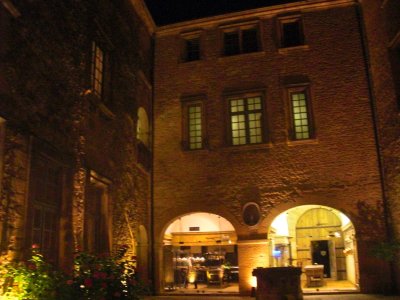
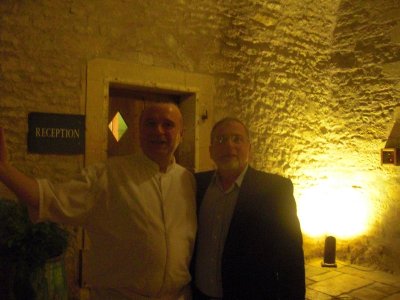 Then we went inside to see the kitchens! At the left is the night view of the two main kitchens through their glass walls from the stone courtyard. The one on the left is the main "cooking" kitchen and that on the right is the roasting kitchen, with an open hearth and large granite-topped table. The dark object in the foreground is the extremely deep well (remember, we're on a mountaintop) that supplied the castle during times of siege. The chef assures us it still has water in it, although it's no longer the hotel's supply. Behind and to the side of the main kitchens are smaller ones for pastry prep, the cold station, etc. Because the walls are so massive and the building is a national historical monument, there can be no question of changing the layout of the floorplan. The kitchens and the chef's office have wonderful vaulted ceilings with the original intricate floral frescos still in place.
Then we went inside to see the kitchens! At the left is the night view of the two main kitchens through their glass walls from the stone courtyard. The one on the left is the main "cooking" kitchen and that on the right is the roasting kitchen, with an open hearth and large granite-topped table. The dark object in the foreground is the extremely deep well (remember, we're on a mountaintop) that supplied the castle during times of siege. The chef assures us it still has water in it, although it's no longer the hotel's supply. Behind and to the side of the main kitchens are smaller ones for pastry prep, the cold station, etc. Because the walls are so massive and the building is a national historical monument, there can be no question of changing the layout of the floorplan. The kitchens and the chef's office have wonderful vaulted ceilings with the original intricate floral frescos still in place.
The chef's name is David Senia (cuisines.chateau@chateaudebagnols.fr; 04-74-71-40-27). The photo shows him with David (Thistle) in front of the entrance to reception, just inside the drawbridge. In answer to our question, he revealed that he's only been at Bagnols for three months. That explains it—neither the 2009 rating nor this year's can have been based on his cooking. We confidently expect an upgrade by next year. For tons more information, and better photos than mine, visit the castle's website, at http://www.chateaudebagnols.co.uk/.
previous entry
List of Entries
next entry

 So much for getting any tourist information about the area. So we just set out to explore the downtown. The Michelin Guide recommended the boiseries in the church, so we started there (always a good place to start—the vast majority of French churches are way older than anything in the US, so there's usually something to see).
So much for getting any tourist information about the area. So we just set out to explore the downtown. The Michelin Guide recommended the boiseries in the church, so we started there (always a good place to start—the vast majority of French churches are way older than anything in the US, so there's usually something to see).
 Villefranche, aside from being Beaujolais Central, is known for its historic architecture. A couple of blocks from the church, we came across this wonderful tiled diagram of the main street, rue National. Each photo shows maybe a quarter of it. At the left is the key to tile color, indicating the century during which each of the buildings was constructed. The church is recognizable by its gold cross. We didn't take time to puzzle out just which building housed our lunchtime restaurant, but it was in about the third block to the right of the church, on the same side of the street.
Villefranche, aside from being Beaujolais Central, is known for its historic architecture. A couple of blocks from the church, we came across this wonderful tiled diagram of the main street, rue National. Each photo shows maybe a quarter of it. At the left is the key to tile color, indicating the century during which each of the buildings was constructed. The church is recognizable by its gold cross. We didn't take time to puzzle out just which building housed our lunchtime restaurant, but it was in about the third block to the right of the church, on the same side of the street.
 The restaurant had a sign on the street, but when you entered through its doorway, you found yourself in a dark, narrow traboule leading to an open courtyard deep within the building. That was furnished with blue-painted metal lawn furniture and sheltered by a large awning.
The restaurant had a sign on the street, but when you entered through its doorway, you found yourself in a dark, narrow traboule leading to an open courtyard deep within the building. That was furnished with blue-painted metal lawn furniture and sheltered by a large awning. 
 I couldn't resist dessert when I saw that they offered a "coupe igloo" (called "coupe iceberg" elsewhere in france), mint ice cream with mint syrup. David shudders at the very thought.
I couldn't resist dessert when I saw that they offered a "coupe igloo" (called "coupe iceberg" elsewhere in france), mint ice cream with mint syrup. David shudders at the very thought.
 On the way back to the car, I talked David into a quick turn through the covered market. Outside, it was all clothing, as far as the eye could see. Inside was the food. In addition to all the normal stuff, they had strange flat turnips, shaped like those seedless "donut" peaches. I hope they're especially tasty, because they sure don't look like fun to peel.
On the way back to the car, I talked David into a quick turn through the covered market. Outside, it was all clothing, as far as the eye could see. Inside was the food. In addition to all the normal stuff, they had strange flat turnips, shaped like those seedless "donut" peaches. I hope they're especially tasty, because they sure don't look like fun to peel.
 At the left is the carriage house (actually more of a shed, but it did have the old carriage in it). I'm standing just inside the postern. Out of the photo to the right is the gravel courtyard where hotel guests park their cars (just inside the big iron gates). Beyond the carriage, you can see a little of the grassy outer courtyard (which the hotel calls the "salon ombragé," the shaded salon) and to the right of it the beginning of the bridge into the inner castle. The right-hand photo shows the whole bridge, including the drawbridge part, and the waiter on his way out from the restaurant to greet us.
At the left is the carriage house (actually more of a shed, but it did have the old carriage in it). I'm standing just inside the postern. Out of the photo to the right is the gravel courtyard where hotel guests park their cars (just inside the big iron gates). Beyond the carriage, you can see a little of the grassy outer courtyard (which the hotel calls the "salon ombragé," the shaded salon) and to the right of it the beginning of the bridge into the inner castle. The right-hand photo shows the whole bridge, including the drawbridge part, and the waiter on his way out from the restaurant to greet us.
 As he seated us at our table, the sommelier (doubling as maître d' that night) mentioned that, if we wanted to repeat the Guichard d'Oingt menu, we could substitute other dishes from the menu for the ones we'd already eaten—very accommodating.
As he seated us at our table, the sommelier (doubling as maître d' that night) mentioned that, if we wanted to repeat the Guichard d'Oingt menu, we could substitute other dishes from the menu for the ones we'd already eaten—very accommodating.
 Second amuse-bouche: Hot frog and seafood soup. Delicious! Each piece of frog was either boneless or semidetached from its bone so that it could conveniently be bitten off.
Second amuse-bouche: Hot frog and seafood soup. Delicious! Each piece of frog was either boneless or semidetached from its bone so that it could conveniently be bitten off.
 Third course: A thick pork chop, grilled and then sliced, on a ragout of baby broad beans, confit tomato, and lardons. Tender and moist, because it wasn't overcooked, as American pork always is.
Third course: A thick pork chop, grilled and then sliced, on a ragout of baby broad beans, confit tomato, and lardons. Tender and moist, because it wasn't overcooked, as American pork always is.
 Mignardises: Same as the night before, but this time with a golden fruit smoothie in the glasses. The restaurant was rated only 15/20 in the 2009 GM and two toques in this year's. After two such meals, we seriously wondered why it wasn't rated higher!
Mignardises: Same as the night before, but this time with a golden fruit smoothie in the glasses. The restaurant was rated only 15/20 in the 2009 GM and two toques in this year's. After two such meals, we seriously wondered why it wasn't rated higher!
 Then we went inside to see the kitchens! At the left is the night view of the two main kitchens through their glass walls from the stone courtyard. The one on the left is the main "cooking" kitchen and that on the right is the roasting kitchen, with an open hearth and large granite-topped table. The dark object in the foreground is the extremely deep well (remember, we're on a mountaintop) that supplied the castle during times of siege. The chef assures us it still has water in it, although it's no longer the hotel's supply. Behind and to the side of the main kitchens are smaller ones for pastry prep, the cold station, etc. Because the walls are so massive and the building is a national historical monument, there can be no question of changing the layout of the floorplan. The kitchens and the chef's office have wonderful vaulted ceilings with the original intricate floral frescos still in place.
Then we went inside to see the kitchens! At the left is the night view of the two main kitchens through their glass walls from the stone courtyard. The one on the left is the main "cooking" kitchen and that on the right is the roasting kitchen, with an open hearth and large granite-topped table. The dark object in the foreground is the extremely deep well (remember, we're on a mountaintop) that supplied the castle during times of siege. The chef assures us it still has water in it, although it's no longer the hotel's supply. Behind and to the side of the main kitchens are smaller ones for pastry prep, the cold station, etc. Because the walls are so massive and the building is a national historical monument, there can be no question of changing the layout of the floorplan. The kitchens and the chef's office have wonderful vaulted ceilings with the original intricate floral frescos still in place.